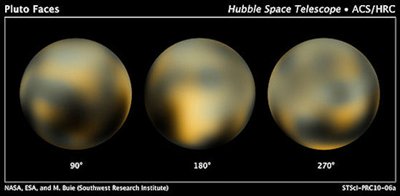 The mass of Pluto is less than .024 percent than that of earth (1.31×10_22 kg). That is roughly seven times (.0021) the mass of Earth. Its diameter is 2,390 km, which is relatively smaller than that of the Earth’s moon. The density on Pluto ranges from 1.8 to 2.1 grams per centimeter cubed.
The mass of Pluto is less than .024 percent than that of earth (1.31×10_22 kg). That is roughly seven times (.0021) the mass of Earth. Its diameter is 2,390 km, which is relatively smaller than that of the Earth’s moon. The density on Pluto ranges from 1.8 to 2.1 grams per centimeter cubed.
The gravity on Pluto is 7% than the gravity of Earth. An object weighting 200 pounds on Earth, would weight 14 pounds on Pluto. Before arriving at this conclusion, many astronomers and scientists made different assumptions on the true mass of Pluto. The first calculation for Pluto’s mass was made on its presumed effect on the Planets Neptune and Uranus.
It was even calculated to be the same mass as Earth. In 1976 the albedo of Pluto was calculated by Dale Cruikshank, David Morrison, and Carl Pilcher of the University of Hawaii. The results show that it was similar to that of Methane Ice. Pluto had to be more luminous for its size if this was the case. It was inferred that Pluto could not possibly have more than 1% of the earth’s mass.
When Charon, Pluto’s satellite, was discovered in 1979 scientists were able to determine the mass of the Pluto-Charon System. They applied Newton’s formula of Kepler’s Third Law. By measuring the gravitational effects of Charon, they were able to determine the diameter of Pluto.
Pluto is smaller and less massive than other planets and moons in the solar system. Pluto has just been recently classified as a dwarf planet. It is even smaller than another dwarf planet called Eris. It is twice the size of another dwarf planet named Ceres. Other moons contain more mass than Pluto. Castillo, lo, Europa, Ganymede, Titan, Triton and the Earth’s moon are all more massive than Pluto.
Discovery of Pluto
